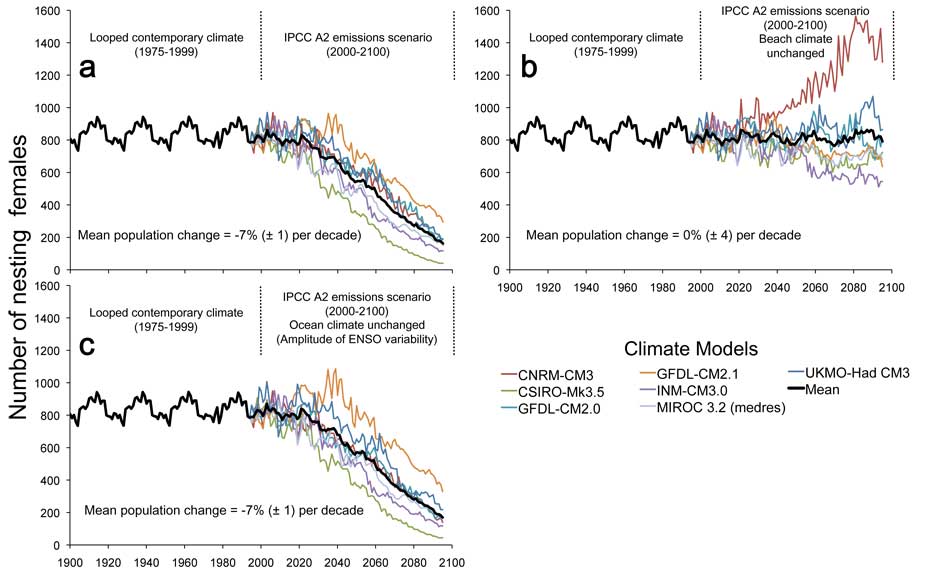July 1st, 2012
Key Findings
- Whereas changes in ocean conditions had a small effect on the population, the ~2.5 oC warming of the nesting beach was the primary driver of the decline via reduced hatching success and hatchling emergence rate.
- Hatchling sex ratio did not substantially change.
- Adjusting nesting phenology (timing) or changing nesting sites may not entirely prevent the decline, but could offset the decline rate.
Vincent S. Saba, Charles A. Stock, James R. Spotila, Frank V. Paladino, Pilar Santidrián Tomillo. Journal: Nature Climate Change. DOI: 10.1038/nclimate1582
Summary
Assessing the potential impacts of climate change on individual species and populations is essential for the stewardship of ecosystems and biodiversity. Marine turtles must lay eggs in sandy beaches and thus climate change can affect both their marine and terrestrial habitat. The population of critically endangered eastern Pacific leatherback turtles (Dermochelys coriacea) nesting on the northwest coast of Costa Rica has been studied in terms of its sensitivity to contemporary climate variability in the nesting beach and ocean.
We combined an earth system model, climate model projections assessed by the Intergovernmental Panel on Climate Change (IPCC), and a population dynamics model to estimate a 7% per decade decline in the nesting population at Playa Grande, Costa Rica over the 21rst century, primarily due to the negative impacts of increased air temperature on hatchling recruitment from the nesting beach.
In northwestern Costa Rica, hatching success, hatchling emergence rate, and the proportion of male hatchlings all increase during cool and wet conditions. Foraging success and reproductive frequency of mature females are enhanced after periods (~ 1 year) of high primary productivity in the eastern equatorial Pacific. Variability in both foraging success of mature females in the ocean and in the local climate in the nesting beach are primarily associated with the El Niño Southern Oscillation (ENSO).
Historic egg poaching and incidental fisheries mortality have rendered the eastern Pacific leatherback population critically endangered. If incidental fisheries mortality is eliminated, this population still faces the challenge of recovery in a rapidly changing climate.
Our projections suggest that climate change could drive eastern Pacific leatherbacks in Costa Rica to extirpation, even in the absence of fisheries mortality. The importance of the beach phase climate response suggests that anthropogenic climate-mitigation of leatherback nests in Costa Rica may sustain present-day hatching success, emergence rate, and sex ratio and therefore maintain a sustainable nesting population. Future recovery plans should consider potential climate-mitigation programs for nests (e.g. shading and irrigation).



